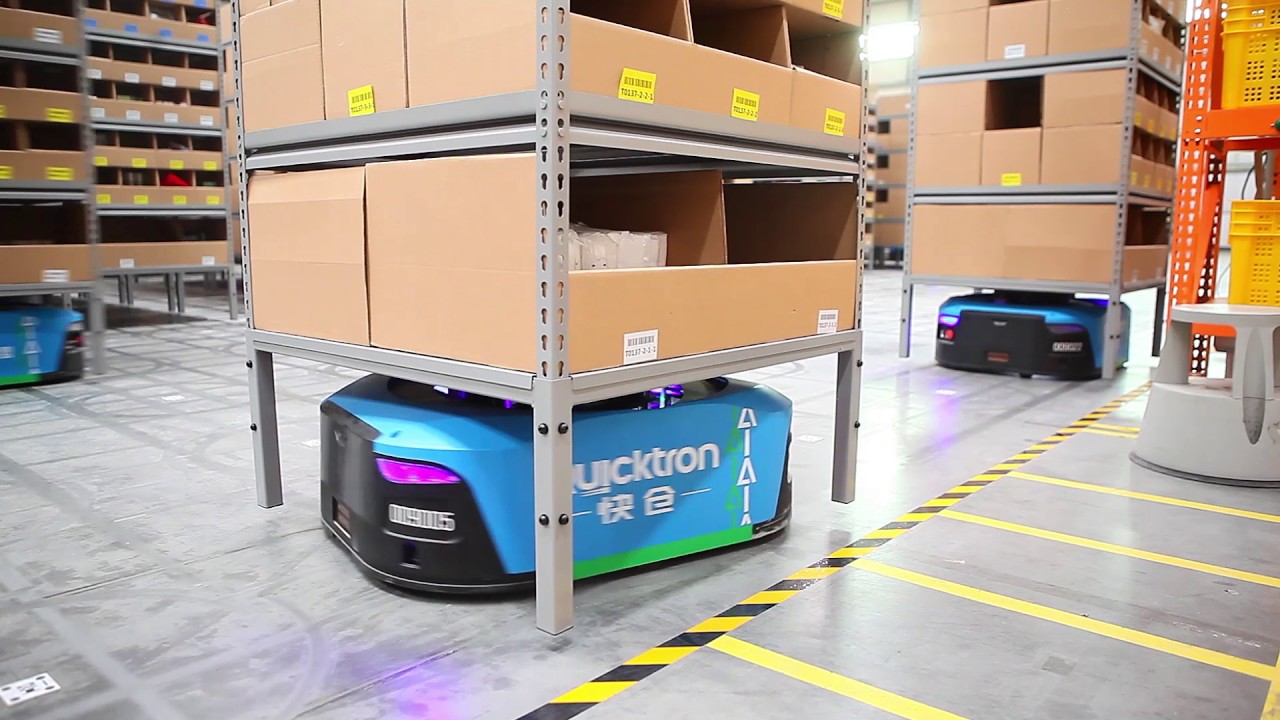In recent years, storage logistics has evolved hand in hand with fields such as robotics, electronics, and automation. A look at some of the innovations in the sector.
Imagine the possibility of incorporating a workforce into your company that works 24 hours a day, seven days a week, without breaks or vacations and for less money.
Although it seems taken from a James Cameron movie, this working landscape is already common in the wineries of Amazon, the e-commerce multinational. There, about 1,000 robots load shelves full of merchandise and take them to the (human) packers, who are in charge of sending them to their recipients. In this way, Amazon has managed to optimize the management of its stores and reduce the delivery time of orders.
According to Jeff Bezos, the executive director of Amazon, by the end of this year, the company will increase the robotic force in its warehouses with 10,000 units. It should be noted that two years ago the e-commerce giant decided to acquire Kiva Systems, the company that manufactured such robots, for a price of 775 million dollars.
Like Amazon, other companies invest large sums of money in their logistics storage centers, which has driven innovation in the sector. Besides, the development of emerging technologies, such as robotics and electronics, have allowed the optimization of different logistics processes and reduced costs.
Next, some of the systems and technologies that are at the forefront of this competitive industry.
Robotic Storage Systems
They are composed of robotics systems and advanced software that improve the operation in warehouses, increase the speed and reliability of merchandise management, and reduce costs in the management of your center, among other advantages. Although automated warehouses require complex specialized software, operators can now handle it easily. With these systems, the productivity of the company will gain in speed, precision, organization, high performance, and total reliability.
WMS Systems
With WMS (Warehouse Management System) or warehouse management systems, manual listings and mnemonic exercises to remember the number of products in the warehouse and their location are past practices. This software allows us to keep an exact and real-time control of the operation, increase the speed of the transactions and have wide visibility of the movements in the warehouse.
In effect, this computer tool identifies the merchandise and shows its location, manages the resources when they are going to be transferred, regulates the workforce, eliminates empty movements and saves the company seconds thanks to the precision of each movement within the warehouse.
To ensure proper operation, a WMS must be accompanied by a server to host the software, a database administrator, wireless networks, guns and radiofrequency terminals for barcode reading.
Its use requires an assembly, adaptation and application process that could take more than a year. It is also important to remember that the success of its implementation depends largely on the training of the personnel that will operate it.
SGA Systems (Warehouse Management Software)
This type of solution allows keeping the inventory continuously updated and to know in real-time the exact quantity and location of each of the products within the warehouse. This information means total traceability, zero material losses and shorter search times.
Radio Frequency Identification (RFID)
This technology facilitates the simultaneous reading of several products avoiding passing them one by one through a reading device; in this way, the storekeeper can know how long the product was stored, in what places, etc. Its use allows knowing the location of any merchandise within the supply chain.
Voice Picking
This technology improves the time of preparation of orders in the warehouses because it allows the operator to receive instructions orally, utilizing a headset and a microphone, and thus remain with the hands-free to devote to other tasks.
Voice Picking helps workers to fully concentrate on the task they are running, by not having to read a screen, a selection list or a purchase order. This tool prevents employees from typing data and at the same time maneuvering the product, which results in efficiency for the process.
Concepts
For many years, whenever we have heard of a warehouse, a great infrastructure has come to mind in which multiple products and elements were stored, which were well stored to sell them in the future. It is true that the word warehouse, as such, practically refers to this concept, however, at present we have to refer to a term: intelligent warehouses. Simply by taking a look at the intelligent word, we can already realize what this will mean, since today multiple elements have been endowed with “intelligence”, so that they work in a much more autonomous and thus profiting the production process, in addition to streamlining our tasks.
In this sense, intelligent warehouses will behave as infrastructures that are equipped with new technologies that will help, at all times, to make the processes that the company has to face much faster, profitable and, above all, productive. To provide a warehouse with the intelligence we are referring to, we have to mention some basic aspects of the new era in which we live. Thus, cloud computing, electronic commerce or even the use of big data, take on a special role. The truth is that this technological innovation is responsible for the use of these intelligent stores today and has become an essential element for traditional stores to evolve to this new concept.
If we want to understand perfectly what exactly an intelligent warehouse is, we have to mention three key aspects:
- Visibility
- Mobility
- Flexibility
Why are they so important within this sector? Although it seems complicated at first, in reality, all this is simpler than it seems. Regarding visibility, it should be said that it takes center stage because it allows users, in advance, to have access to the information necessary to be able to carry out their tasks. Also, always taking into account that all this can be done in real-time. On the other hand, it is also important to emphasize this concept due to the technological means that are used now, such as tablets or smartphones.
As for mobility, it is also a concept of great importance, since it will allow stores to be optimized, making them a profitable place and beyond simple infrastructure to “store things”. For this reason, it is increasingly investing in technology and not so much in the equipment that accompanies it. Finally, in terms of flexibility, we talk about a flexible architecture, which means that we can carry out multiple tasks quickly, easily and with the greatest efficiency.
Goals
When companies decide to bet on smart stores it is because they are clear that the objectives that are going to be achieved with them will be very beneficial for the business. Without going any further, one of the main objectives that are attempted to be achieved through intelligent warehouses is the increase in productivity, as well as, consequently, losses due to the process carried out within these infrastructures will be significantly reduced.
Similarly, another primary objective is the improvement of distribution and that is why smart warehouses have become strategic points for current businesses.
The change is significant, the stores are no longer large stores to store items, now they are much more, they are distribution points appropriate to the times, equipped with the best technologies of the moment to streamline processes and for the business to prosper as it is due. They are infrastructures that have the necessary equipment to increase the profits of the companies and also to be able to satisfy the demand of the users in a much more agile way.
Nowadays, to store, the technological processes with which these intelligent stores have been endowed are required, taking into account that this will always help to have greater growth in the company. These are automated, faster processes that allow, among other things, to control merchandise to a greater extent.
Technologies
As for the technologies that we can highlight concerning smart warehouses, two are used in particular:
- ERP applications
- Bin picking
- Code reading
ERP Applications
ERP stands for Enterprise Resource Planning, which translates as Enterprise Resource Planning. It is an application that is integrated into the management systems and is mainly used to control the inventory within the corresponding warehouse.
Also, with this application, you can add other important tasks for the process, such as billing, orders or even logistics. Although ERP applications are highly recommended, they are normally used in retail and have a very well defined objective, which is none other than inventory turnover.
Bin Picking
When we talk about Bin Picking we are referring to Vision Guided Robotics Systems (VGR). It is a new methodology that can select and extract a particular piece within a batch of articles. Using an intelligent clamp, the piece in question is chosen from among many others and later, it is deposited in another bucket so that it can be used for other purposes. All this is possible, thanks to the 3D vision system that can detect the piece that interests us.
The Bin Picking process is simple, a visual scan is made between all the pieces, then the specific object is identified, then the piece is removed and finally, it is placed in another place.
Code Reading
When we talk about the type of OCR (Optical Character Recognition) reading, we find that the Merlin 3 algorithm is capable of reading a letter, number or combination of both, whatever the source has been used, even the “dot-print ”, Making a reading with great precision and robustness. Something that conventional OCR reading systems are not able to carry out since they have to be “trained” based on a real capture of the image to be processed.
Benefits
Regarding the benefits that intelligent stores bring us, we can highlight the following:
- Reduce the times in which the processes are carried out
- It helps improve the accuracy of the results, both real and planned
- Save the cost of labor
- It favors that there is a more exhaustive control about the entrances and exits of the different merchandise
Bringing these benefits to any type of business is a very good way to increase your performance and productivity in a satisfactory way, which is why smart stores have been gaining increasing popularity in the market.






